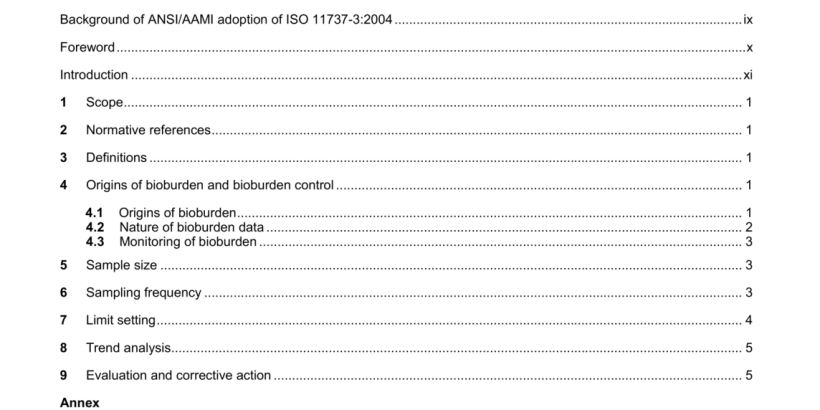ANSI AAMI ISO 11737-3-2004 pdf download
ANSI AAMI ISO 11737-3-2004 pdf download.Sterilization of medical devices – Microbiological methods
4.1.2 In some cases, the most significant contributor to product or component bioburden is a raw material. Raw materials of natural origin often have a high bioburden exhibiting a great deal of variability. A raw material of natural origin can also introduce microorganisms that generally are not present on medical devices. Synthetic raw materials usually have lower and less variable bioburden. If the raw material can support microbial growth, this can significantly influence the bioburden.
4.1.3 The method of manufacture of components can have an impact on their bioburden. The hand cutting of material into components or the manual handling of materials contributes to bioburden and may increase variability. Molding under high temperature and pressure on the other hand can produce components that have low bioburden. Bioburden on such molded components is usually the result of handling or exposure to the environment. If this is controlled, the bioburden will remain low with lttle variability.
4.1.4 Product and component handling during assembly and other production activities, such as inspection, have been identified as being a major contributor to product bioburden. Automated assembly processes have been shown to produce products with lower bioburden and less variable bioburden than manual assembly processes. Manual assembly results not only in higher bioburden but also in greater variability. If the assembly process is complex, the bioburden may increase due to the length of exposure to the manufacturing environment and the number of steps where bioburden could be introduced.
4.1.5 The manufacturing environment and the extent of control of that environment can have an impact on bioburden. Prolonged exposure of components or products to an uncontrolled environment can be a significant contributor to high levels of bioburden. If the manufacturing environment and practices do not provide barriers between the product and an uncontrolled environment, the product bioburden can show shifts in numbers and types (e.g., genus and species or morphological state, such as vegetative versus spores) due to climatic and seasonal changes. Work surfaces in the manufacturing environment can also accumulate microorganisms that can be transferred to components and products during assembly.
4.1.6 Assembly aids, such as compressed gases, water, lubricants, etc., can be a source of bioburden, and their use can result not only in increased levels but also in large variability. If these assembly aids support microbial growth, the level of bioburden and its variability may increase. A final cleaning step prior to packaging can reduce both the overall level of bioburden and the variability. If the cleaning process leaves a residue in/on the product, however, the opposite effect can occur, resulting in increased bioburden and variability.
4.1.7 Just as with automated assembly, automated packaging will contribute fewer organisms, and there will be less variability than with manual packaging. Packaging components of plastics or nonwoven synthetic materials are generally not substantial contributors of bioburden. However, if paper products are part of the primary package, they may have a higher bioburden than the product being packaged.
7.1 Acceptable limits are stipulated for allowable bioburden levels in accordance with ISO 11737-1, 8 and a predetermined course of action (see clause 9) has to be followed when limits are exceeded. If corrective actions lead to changes to the process that affect the bioburden level, new bioburden data should be gathered and new limits established for the product when necessary.
7.2 The limits used for monitoring bioburden data are based upon historical data for a product. In the absence of such historical data, tentative limits can be set upon evaluating the first three batches of a given product. Based upon successive test results, these should be reevaluated after a period of time to verify whether these original limits were appropriate.
7.3 Bioburden data collected for a product may not precisely follow a well-recognized mathematical distribution. In particular, some bioburden data exhibit many zero counts with a few high counts, and a histogram representing such bioburden data will exhibit a long tail to the right. If a mathematical distribution can be ftted to a given set of data, upper limits for the data may then be set accordingly. Thus, an upper probability limit can be chosen (perhaps the 95 % or 99 % probability limit) for the bioburden that should not be exceeded if the production process continues to operate in the same manner as that used to gather the historical data.
